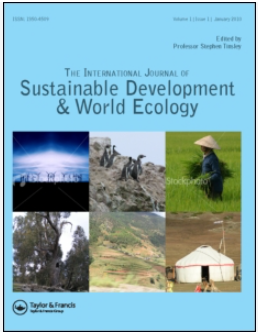Impact-oriented assessment of carbon, water and energy footprints for maize production: a case study in Shandong, China
IF 7.7
3区 环境科学与生态学
Q1 ECOLOGY
International Journal of Sustainable Development and World Ecology
Pub Date : 2023-09-30
DOI:10.1080/13504509.2023.2263852
引用次数: 0
Abstract
ABSTRACTThe continuously increasing demands of food, feed and various corn-derived products accelerate the concern about the corn production on environment. Nevertheless, few researches simultaneously address the issue from different perspectives of carbon, water and energy as well as their temporal variations. Herein, a systematic cradle-to-gate life cycle assessment of maize production was conducted with a case study in Shandong, China. Different midpoint and endpoint indices including 10-year average data from 2011 to 2020 and their temporal variations were investigated. The contribution analysis of different processes to these indices revealed that irrigation dominated the midpoint of water scarcity, whereas the sum of direct consumption, fertilizer and diesel production contributed more than 80% to all the other indices. The sensitivity analysis also illustrated that these environmental indices can be reduced by as high as 4% when the aforementioned inputs were individually decreased by 5%. The temporal variation of the global warming potential, aquatic eutrophication and fossil depletion demonstrated that all the three indices were decreased by about 25.0%–31.7% over the last decade. Further persistent efforts to enhance mechanized operation efficiency and explore green and efficient methods for fertilizer and diesel production were highlighted. Moreover, implementations of rational agricultural management such as scientific fertilization and water-efficient irrigation were suggested, in order to have an eco-friendly maize production system.KEYWORDS: Life cycle assessmentmaize productioncarbon footprintwater footprintenergy footprinttemporal variation AcknowledgmentsThis work was supported by the National Natural Science Foundation of China under Grant No. 21868011 and the Foundation of Guangxi Key Laboratory of Plant Functional Phytochemicals and Sustainable Utilization under Grant FPRU2020-2.Author contributionsXuan Wang: Investigation, data processing, data curation, writing – original draft.Lei Xiao: Visualization, data curation.Zhenyan Fan: Methodology, formal analysis.Yueyuan Chen: Investigation, funding acquisition.Zhifang Cui: Conceptualization, writing – review and editing, supervision, and funding acquisition. All authors contributed to the study conception and design.All authors jointly reviewed and approved the manuscript for publication.Availability of data and materialsThe datasets used or analyzed during the current study are available from the corresponding author on reasonable request.Disclosure statementNo potential conflict of interest was reported by the authors.Additional informationFundingThis work is supported by the National Natural Science Foundation of China (No. 21868011), the Foundation of Guangxi Key Laboratory of Plant Functional Phytochemicals and Sustainable Utilization (FPRU2020-2) and the financial support from Shandong University of Science and Technology.以影响为导向的玉米生产碳、水和能源足迹评估:以中国山东为例
摘要随着人们对食品、饲料和各种玉米衍生产品需求的不断增加,人们对玉米生产对环境的担忧日益加剧。然而,很少有研究同时从碳、水和能源的不同角度及其时间变化来解决这一问题。本文以山东省为例,对玉米生产从摇篮到大门的生命周期进行了系统评估。研究了2011 - 2020年10年平均数据的不同中点和终点指数及其时间变化。不同过程对这些指标的贡献分析表明,灌溉在水资源短缺的中点占主导地位,而直接消费、化肥和柴油生产的总和对其他所有指标的贡献都超过80%。敏感性分析还表明,当上述投入单项减少5%时,这些环境指标最高可降低4%。全球变暖潜势、水体富营养化和化石耗竭的时间变化表明,近10年来这3个指标均下降了约25.0% ~ 31.7%。进一步坚持不懈地提高机械化作业效率,探索绿色高效的化肥和柴油生产方法。在此基础上,提出实施科学施肥、节水灌溉等合理的农业管理措施,构建生态友好型玉米生产体系。关键词:生命周期评估玉米产量碳足迹水足迹能源足迹时间变化王轩:调查、数据处理、数据整理、写作——原稿。雷晓:可视化,数据管理。范振岩:方法论,形式分析。陈月媛:调研,资金获取。崔志芳:概念、写作、审编、监督、资金获取。所有作者都对研究的构思和设计做出了贡献。所有作者共同审阅并批准稿件发表。数据和材料的可获得性本研究中使用或分析的数据集可根据通讯作者的合理要求提供。披露声明作者未报告潜在的利益冲突。项目资助:国家自然科学基金(No. 21868011)、广西植物功能化学物质与可持续利用重点实验室(FPRU2020-2)和山东科技大学资助。
本文章由计算机程序翻译,如有差异,请以英文原文为准。
求助全文
约1分钟内获得全文
求助全文
来源期刊
CiteScore
11.10
自引率
3.60%
发文量
58
审稿时长
18-36 weeks
期刊介绍:
The International Journal of Sustainable Development and World Ecology is now over fifteen years old and has proved to be an exciting forum for understanding and advancing our knowledge and implementation of sustainable development.
Sustainable development is now of primary importance as the key to future use and management of finite world resources. It recognises the need for development opportunities while maintaining a balance between these and the environment. As stated by the UN Bruntland Commission in 1987, sustainable development should "meet the needs of the present generation without compromising the ability of future generations to meet their own needs."

 求助内容:
求助内容: 应助结果提醒方式:
应助结果提醒方式:


